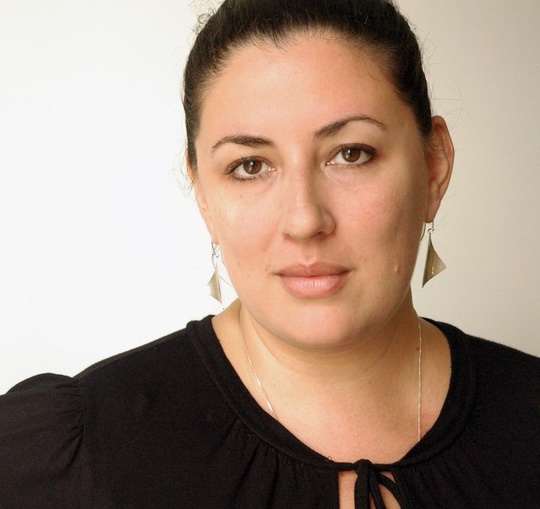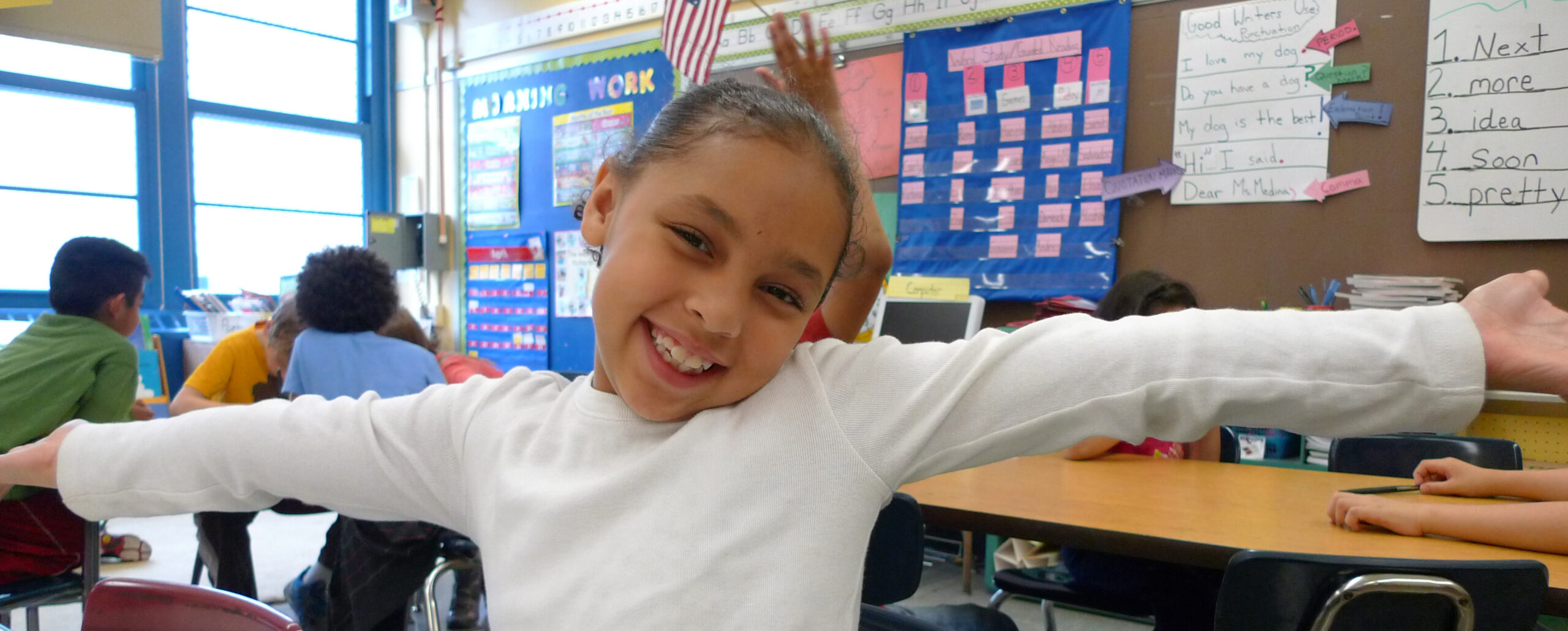Sarah Guayante, a student at St. John’s University and a T&W editorial intern, interviewed teaching artists who took part in the TATIP* program. Maria Schirmer, an interdisciplinary artist working with Community-Word Project, attended the Universal Design for Learning and Teaching for Special Needs workshop facilitated by Philip Alexander of Brooklyn Arts Council and Martin Urbach of Marquis Studios.
Teachers & Writers: Where do your experiences as a teacher and writer overlap? Does your experience as a writer influence your work as a teacher?
Maria Schirmer: As an artist and as an educator, there’s an enormous amount of overlap between the way I work and am inspired as a writer and the way that work inspires my students. Vice versa, the way that my students work and the work of my students subsequently inspires my work. I feel pretty strongly about that. That is certainly something that I have always aspired to as an educator. If the work can show between my art process and the work that I am doing with my students, then it’s not two separate things.
T&W: You mentioned that there were times when your students inspired your art. Can you expand on a specific time where the work of a student has inspired you?
MS: I’m always intrigued and inspired by the way students engage with writing prompts because I think that, no matter the age group, a writing prompt is a writing prompt, and it can work for young students and for adults. If I witness a student that suddenly has this moment of creativity with a writing prompt, sometimes I question why I’m not giving these prompts to myself. I like watching the way a student’s mind can engage with the information and with a prompt. I’m particularly inspired by teaching elementary school-aged kids. In the past couple of years, I’ve taught first and second grade, and I think there’s something so wonderful about the way that an elementary school kid’s mind is completely wild. They’ll say things that are wild and maybe don’t make sense, but that are so interesting to see or to hear. There is also that sort of useful straightforwardness that I really appreciate. I think as an adult and as a writer, the excess and the flowery language can take over. Watching young people just lay it out there without all of the filigree is really interesting and it reminds me that sometimes less is more.
T&W: When you are in the classroom, what are the most important things about writing that you want to communicate to your students?
MS: Number one, I want to communicate that there are no wrong answers. Yes, revision can happen and work can get stronger, but I am not extremely focused on grammar. Editing will come later, making sure that everything is spelled properly will come later. As someone who is a terrible speller and struggles with grammar, I don’t want students to get in their head with that. I can get in my head with that. I was always told, “Oh, your story is awful. Well, that’s grammatically incorrect.” So, I really want my students, at least at the very beginning, to feel that they have that total freedom, poetic license, whatever you want to call it, to get the ideas on the page. When we then move on to the revision period, or the editing period, it’s not because what was done before was bad or a problem, but that things can always be improved and become more creative. The details of the grammar and spelling will come later.
T&W: Where have you seen a student become opened up to that poetic freedom?
MS: One year, with the Community-Word Project, I was working with a group of first-grade students. I was very fortunate to be able to go back to the same school the next year and work with the first-grade students when they were in second grade. A lot of time we are in a classroom for 12 or 15 weeks; if you’re lucky a year-long residency. To have two years with these students, it was quite extraordinary to see the way they matured and were more creative and let themselves go. They were feeling more comfortable and more confident to share their ideas. It helped that we were able to reference what we did last year and then bring that into the work this year, and able to reflect.
T&W: In your experience, what does including arts education in the curriculum give to students?
MS: Everything. I am such an incredible advocate of arts education and I always think about the way that arts education enriches things. Being a teaching artist in an English class, it’s going to make your vocabulary better, if you’re teaching a writing workshop. That’s incredibly important. But, I think that arts education in general—be it writing or theater or acting or what have you—naturally requires students to work together. Teamwork and collaborative learning and creation is such a vital skill. It doesn’t matter if it’s an English class, or a math class, or a science class, or whatever. I think arts education naturally encourages students to work as a team and create collaboratively. That skill is going to take them beyond the classroom, into life, into adulthood, into professional careers. To me, that is the number one value of arts education.
T&W: Did you have an arts education growing up?
MS: I did. My parents are artists. My father’s studio was in our home, and so I was incredibly fortunate. To me, growing up as a kid having artist parents and having friends with artist parents, I thought everybody’s parents were artists. When I went to a school and I saw parents that carried briefcases and going into offices I thought, “Oh, that’s odd,” which I realize is the complete opposite of what normal people experience.
I also went to a school that had an artist-in-residence, and so arts education was a major component. It was so vital for me. There was also a lot of theater. I’m a theater artist as well, and I’m so fortunate to have been involved in theater from a very, very young age. It is upsetting to me that arts education is not something that is naturally in all schools.
T&W: How do you design your lesson plans? What sparks them? Do you use any online resources, books, or magazines that you would recommend to other teaching artists?
MS: One thing that’s really wonderful about working with Community-Word Project is that we work in teams. There are always two people in the classroom of two different artistic backgrounds. There is always something interesting that happens when working with someone of a different genre. Being able to talk it out with your partner is so helpful. It can be very hard to create lesson plans well. At the end of the day, if it was just you and the classroom teacher, solo teaching, the teaching artist ends up understandably doing a bulk of the labor. To be able to talk it out with my teaching partner is how the majority of my lessons are created: throwing ideas out, seeing what works, talking through it and going from there.
The Poetry Foundation website is definitely my go-to website for finding poems that are appropriate to teach in the classroom. It’s kind of magical. I’ll go type in like “old poem about a city” or “color poem.” I’ll end up finding an abundance of poems and it’s hard to choose which one.
I also respectfully steal from my friends and colleagues. The best resource is the people that we work with and the colleagues that we have. I’m all about asking these questions and CWP collects lesson plans from over the years and has an online resource for us.
T&W: What is one big takeaway from the TATIP Universal Design for Learning and Teaching for Special Needs seminar?
MS: The Universal Design for Learning is not just specific to the special needs classroom. I went into the workshop thinking, “Oh, I’m going to a workshop today to learn about teaching kids with special needs.” Yes, that was a component of it. But, I realized that if a lesson plan is designed thoughtfully and thoroughly, it doesn’t matter what kind of classroom you’re in. This idea that retrofitting a lesson to suit the needs of a self-contained class is doing a disservice to those students. I was incredibly struck by the visual of a ramp being added onto a staircase and the idea that we’re doing a disservice to our students as well if we are just retrofitting the lesson.
Thinking about the social justice aspect of it, I aspire to be a successful social justice educator. For me, Universal Design for Learning is teaching for social justice because you are covering all of your bases before you even step through the door.
*The “TATIP Cohort” is part of Community-Word Project’s eight-month Teaching Artist Training and Internship Program (TATIP). This select group of New York City arts education organizations is a partnership initiative to expand professional development not only for the TATIP students, but also for teaching artists working with these organizations. Our mission is to combine efforts to better prepare artists to bring arts to city classrooms. With professional development seminars that deconstruct the dynamics of teaching artistry in a variety of settings and focus areas, the January-May Saturday sessions are geared towards developing new ways of stimulating creativity and understanding in students.
The TATIP Cohort partners with Community-Word Project include:
Brooklyn Arts Council
Center for Arts Education
DreamYard Project
FreeArts NYC
MagicBox Productions
Marquis Studios
Maxine Greene Center
National Dance Institute
New Victory Theatre
Teachers & Writers Collaborative
Wingspan Arts
Voices Unbroken
Teachers & Writers Magazine is published by Teachers & Writers Collaborative as a resource for teaching the art of writing to people of all ages. The online magazine presents a wide range of ideas and approaches, as well as lively explorations of T&W’s mission to celebrate the imagination and create greater equity in and through the literary arts.



